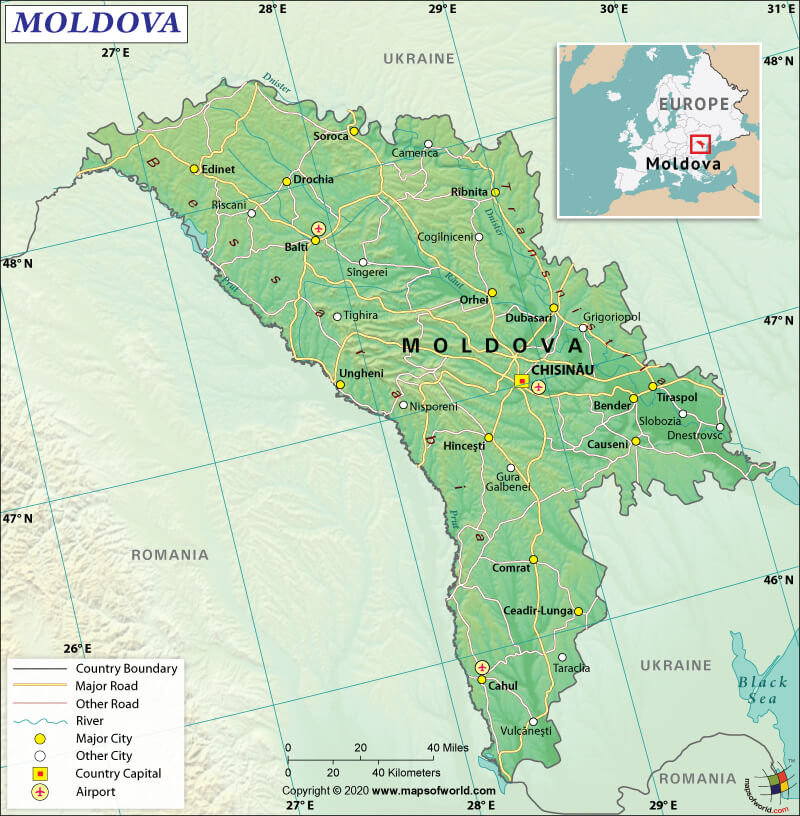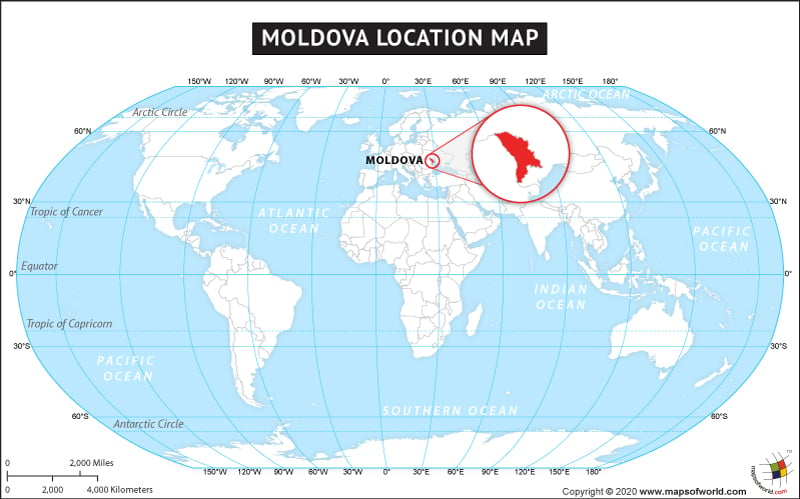What are the Key Facts of Moldova?

|
Official Name |
Republic of Moldova |
|
Continent |
Europe |
|
Capital |
Chișinău |
|
Largest City |
Chișinău |
|
Coordinates |
47.000000, 29.000000 |
|
Area |
13,070 sq. mi (33,851 sq. km) |
|
Land Boundaries |
1,171 mi ( 1,885 km) |
|
Coastline |
0 mi ( 0 km) , landlocked |
|
Currency |
Leu (MDL) |
|
Neighboring Countries |
Romania, Ukraine |
|
Population |
2,657,000 (World Bank, 2019) |
|
Official Languages |
Romanian (Moldovan) |
|
Major Religion |
Christianity |
|
National Day |
27 August (Independence Day) |
|
National Anthem |
“Limba noastra” |
|
Form of Government |
Unitary parliamentary constitutional republic |
|
President |
Igor Dodon |
|
Prime Minister |
Ion Chicu |
|
GDP per capita (PPP) |
$ 13,574.1 (World Bank, 2019) |
|
GDP per capita (nominal) |
$ 4,498.5 (World Bank, 2019) |
|
HDI |
0.711 (2019), Rank: 107 |
|
Literacy Rate (%) |
99.36 (UNESCO, 2014) |
|
Space Agency |
NA |
|
Military Expenditure Ranking |
137 (SIPRI, 2019) |
|
No. of Olympic Medals |
5 (as of 2018) |
|
Driving Side |
right |
|
Calling Code |
373 |
|
Time Zone |
UTC+2 (EET), Summer (DST) UTC+3 (EEST) |
|
Internet TLD |
.md |
Where is Moldova?
Moldova is a landlocked country in Eastern Europe. It shares its border with Romania to the west and Ukraine to the east, north, and south.
What is the Geography of Moldova?
To begin with, Moldova is spread over a total area of 33,851 sq. km (13,070 sq. mi), out of which 32,891 sq. km (12,699 sq. mi) is land area and just 960 sq. km (371 sq. mi) is the water area. It has a 1,885 km (1,171 mi) long land boundary that is shared with Ukraine (1,202 km or 747 mi) and Romania (683 km or 424 mi). There is no coastline as it is entirely landlocked.
Further, the highest elevation point of Moldova is Dealul Balanesti at 430 m (1,411 ft), and the lowest point is Dniester (Nistru) at 2 m (7 ft). The country’s mean elevation is 139 m (456 ft), and some of the significant mountains include Dealul Bălăneşti, Dealul Măgura, Gora Redi, Gora Kashul’, Dealul Cerniţa, and others. Some of the major rivers of the country are Dniester and Prut.
The topography of Moldova is relatively rugged. Though the terrain is hilly, its elevation never crosses 430 m (1,411 ft). The hills slope towards the Black Sea as they move towards the southern direction. Despite being close to the Black Sea, Moldova is landlocked. The Moldovian plateau (part of the Carpathian Mountains) includes the hilly regions. Steep forested slopes cover most of the plateau and are interlaced by ravines and valleys.
Besides, the country can be divided into three regions: the Dniester Hills, the Moldovian Plain, and the Central Moldovian Plateau. The Dniester Hill region includes both northern Moldavian hills and the Dniester Ridge. Middle Prut Valley, as well as Bălți Steppe, comes within the Moldavian Plain. The Central Moldovian Plateau consists of Cornești Hills-Codri Massive, Ciuluc-Soloneț Hills, Tigheci Hills, Lower Prut Valley, and Lower Dniester Hills.
The southern part of the country includes the Bugeac Plain (a small flatland). The territory located to the east of the Dniester River has two geographical regions. While one is Podolian Plateau, the other is the Eurasian Steppe.
Overall, the climate of Moldova can be categorized as moderately continental (mainly because of its proximity to the Black Sea). This climate is characterized by mild cold during autumn and winter while it has relatively cool weather during spring and summer.
Generally, the summer season lasts for a more extended period, with the average temperature around 20 °C (68 °F). Winter season is mild and is relatively dry. The average temperature generally revolves around −4 °C (25 °F). The extent of rainfall varies between the northern and southern parts of the country. The average annual rainfall in north Moldova remains around 600 mm (24 in), and the same in the southern region remains around 400 mm (16 in). In certain places and certain years, long periods of dry spells are not unusual. The heaviest rainfall takes place during early-summertime as well as the month of October. Rains usually accompany thunderstorms.
What is the Economy of Moldova?
Moldova is one of the poorest European countries, and its economy is characterized as a small lower-middle-income economy. Since 2000, it has consistently promoted and has been successful in the promotion of inclusive growth. The poverty rate had decreased sharply from 54.6% in 2001 to 9.6% in 2015. On average, the Moldovan economy has grown by 5%. In 2018, the nominal GDP of the country was US$11.309 billion, and the economy increased at a rate of 4%. The unemployment rate in 2017 was 4.1%.
Moreover, disposable income increased significantly, thanks to the curtailment of taxes, increase in wages, and remittances. Investment also witnessed impressive growth due to the significant increase in public investments, favorable interest rates, and lower inflation. Net exports dipped by 3.4% because the imports increased more rapidly than exports. The construction sector grew by 1.1% due to increased government spending and favorable financial conditions. The wholesale and retail trade and industry jumped by 1.8%, but the agricultural sector almost stagnated (increasing by a marginal 0.2%) after witnessing three years of a good harvest.
During 2019-21, the economy of Moldova is expected to decelerate below its historic values because of the expected weaker demand (foreign and domestic) as well as lower remittances.
What is the Transportation System of Moldova?
Moldova has over 9,352 km (5,811 mi) of roadways. Most of the roadways (8,835 km or 5,490 mi) are paved, and only 517 km (321 mi) are unpaved. Railways are also considerably developed. Out of the total (1,171 km or 728 mi) railway network, almost all (1,157 km or 719 mi) is a broad gauge, and just 14 km (9 mi) is standard gauge. There are seven airports in Moldova. While two have paved runways, five have unpaved runways. Over 558 km (347 mi) of waterways (mainly on Danube, Prut, and Dniester) are also functional. The country has 151 merchant marine ships.
What International Organizations is Moldova part of?
WTO, IMF, UN, Interpol, BSEC, CD, ILO, CE, Union Latina, CEI, UNESCO, CIS, WHO, EAPC, UNCTAD, EBRD, FAO, GCTU, UNIDO, GUAM, IAEA, IBRD, UNHCR, ICAO, ICCt, ICRM, IDA, IFAD, IFC, IFRCS, IMO, IOC, IOM, IPU, ITU, MIGA, OIF, OPCW, OSCE, PFP, SELEC, UNMIL, UNMISS, UNOCI, UNWTO, UPU, WCO, WIPO, WMO, EAEC (observer), ICC (NGOs), ITUC (NGOs), ISO (correspondent)


